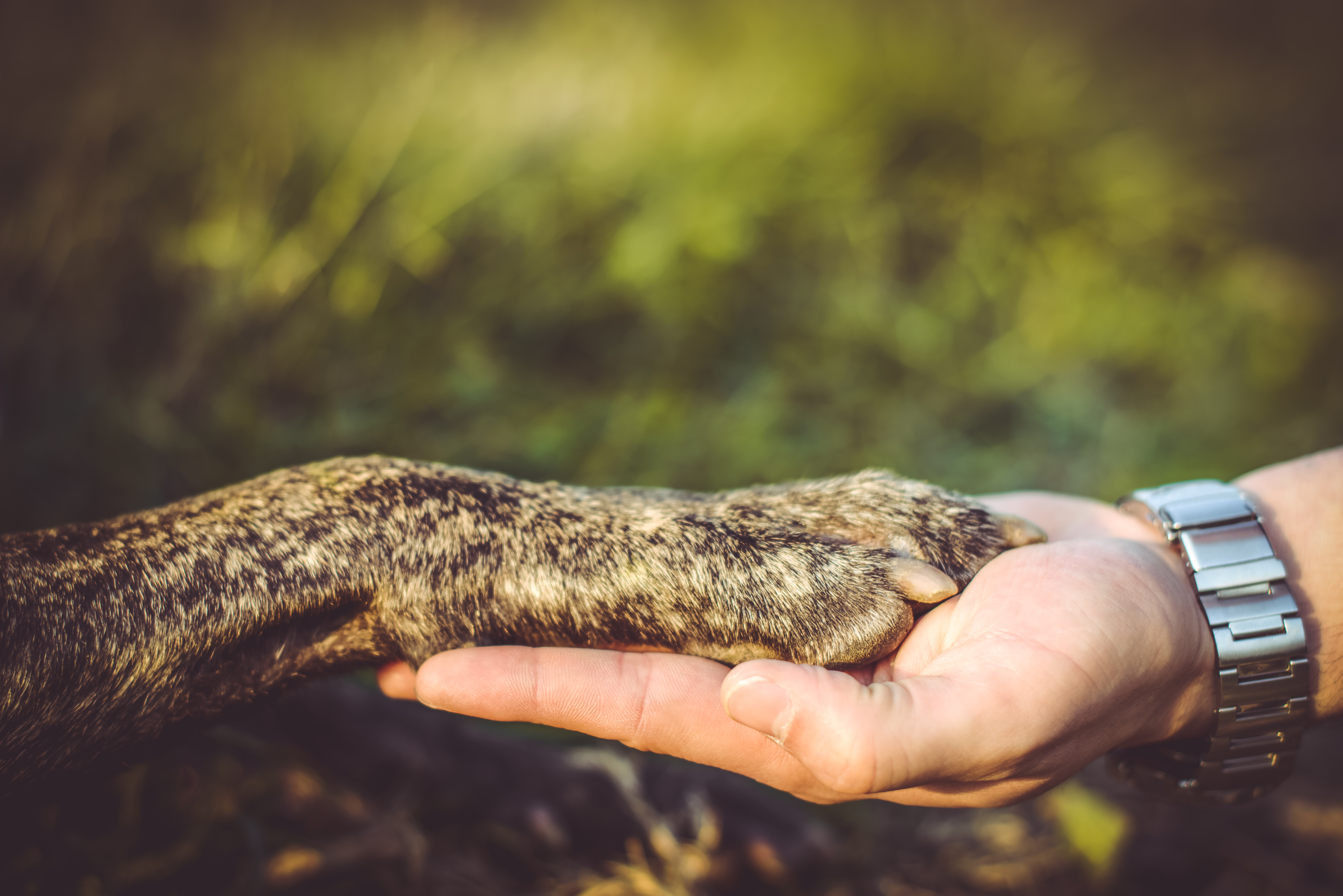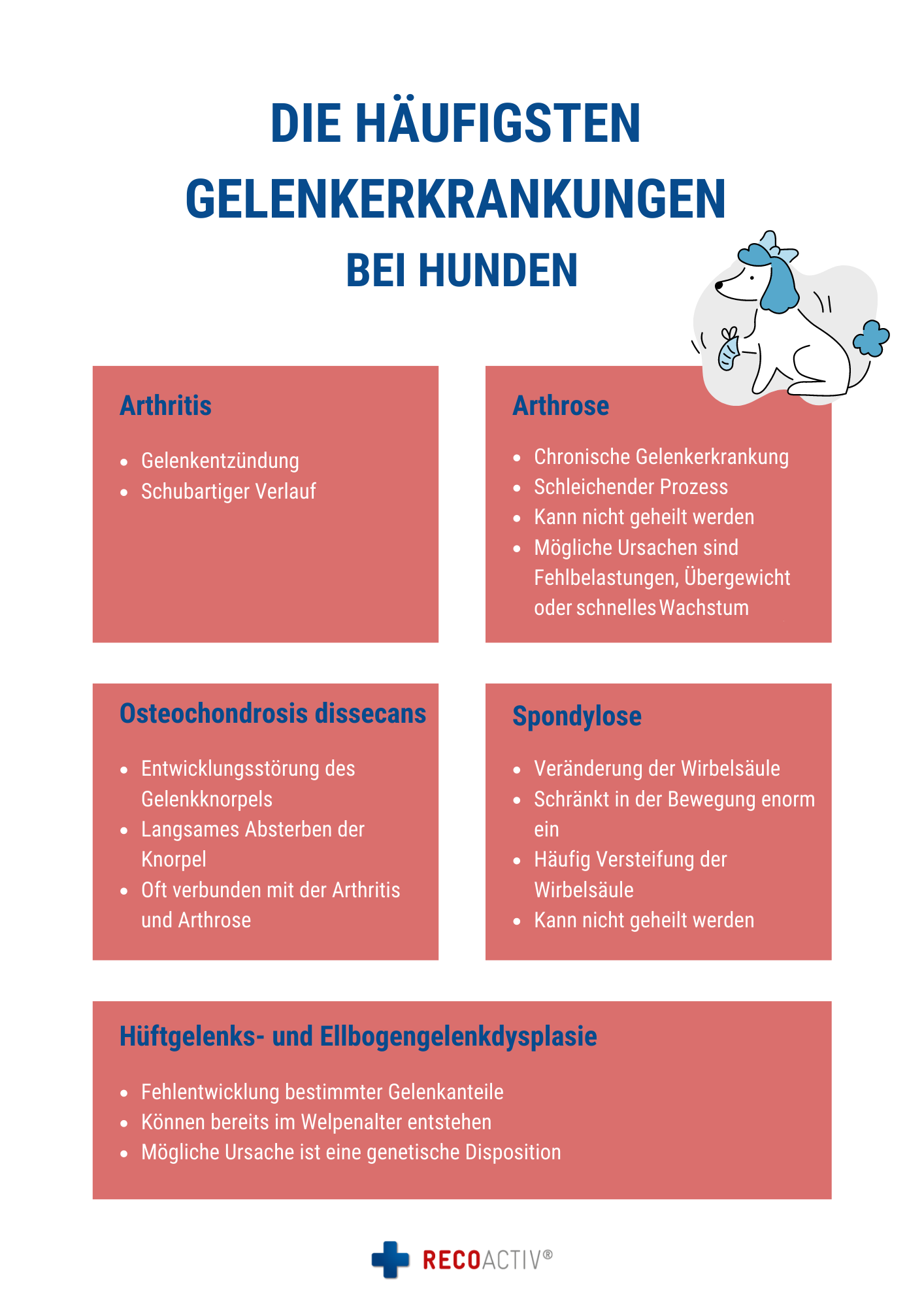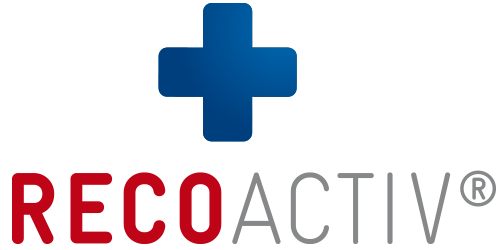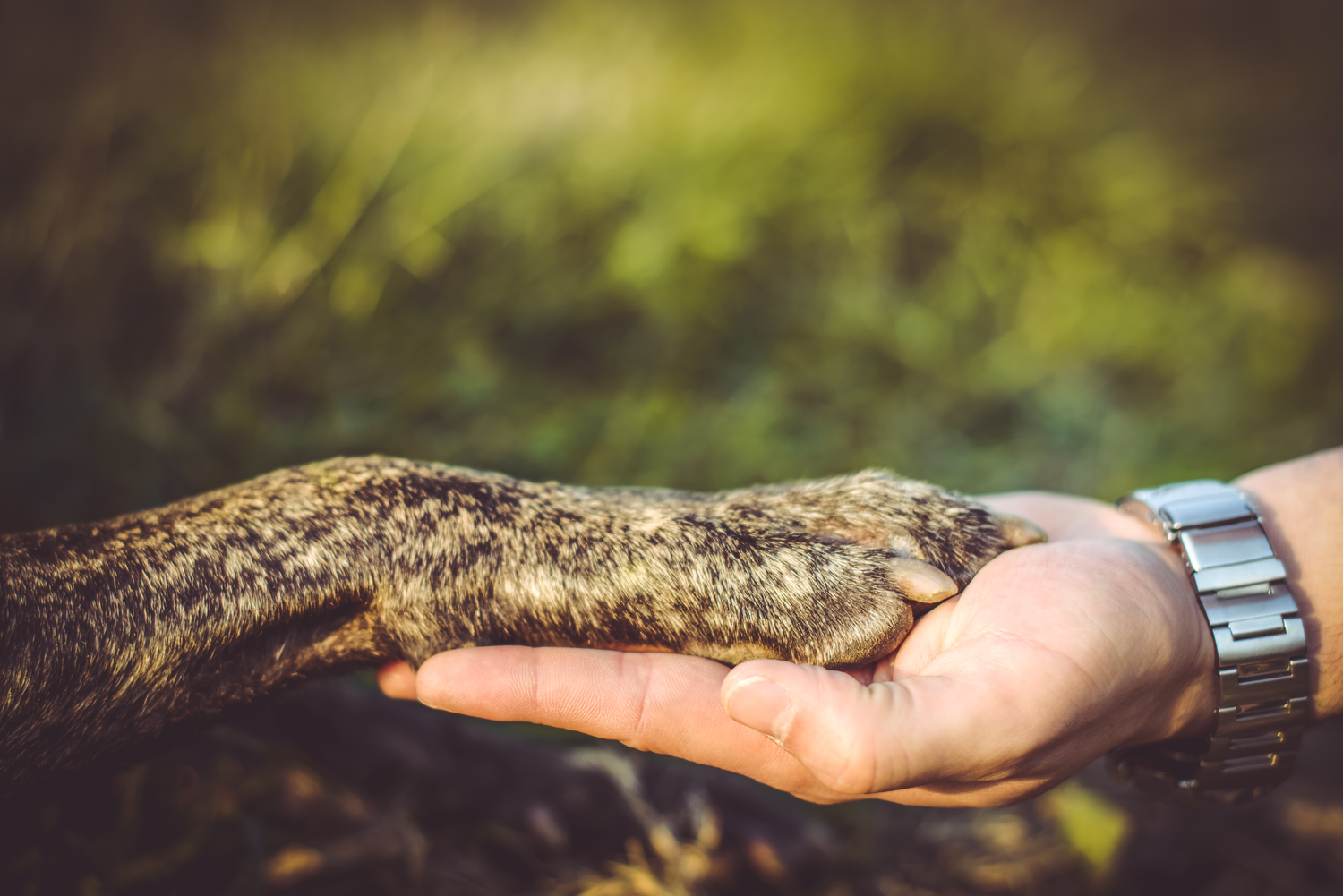Joint diseases and skeletal developmental disorders occur primarily in large dogs, but are also sometimes a problem in small breeds. The causes are not only hereditary, but also partly due to dietary errors or incorrect stress.
In this article we explain which joint diseases primarily occur in dogs and also look at typical causes.

Forms of joint diseases
Joint diseases occur in dogs in various forms. These are not always easy for dog owners to distinguish. Only trained veterinarians can provide information about what the actual illness is, as they have the necessary specialist knowledge and the ability to carry out a detailed examination.
Arthritis and arthrosis
These two joint diseases sometimes have similar symptoms . While arthritis involves inflammation of the joints, which usually progresses in fits and starts, osteoarthritis affects the joint cartilage , which slowly breaks down.
Osteoarthritis occurs relatively frequently in dogs . It is a chronic joint disease that cannot be cured. Once it occurs, it progresses over time and causes the destruction of the articular cartilage. Ultimately, the entire joint is affected.
Possible causes of osteoarthritis in dogs are:
-
Congenital and acquired misalignments or incorrect loading of joints
-
Injuries that have not healed well
-
too rapid growth in large breeds
-
Overweight
Unfortunately, osteoarthritis is often noticed too late because it begins gradually and clear signs only appear when the joint cartilage has already been severely damaged .
Hip Dysplasia (HD) & Elbow Dysplasia (ED)
They are probably one of the most common joint diseases in dogs : hip and elbow joint dysplasia. Dysplasia refers to the incorrect development of individual joint components . In the case of hip joint dysplasia, this means that the dog's hip joint does not develop properly. In larger dog breeds it often develops in puppyhood .
In HD, an abnormal formation of the hip socket occurs, which means that the head of the femur no longer sits correctly on the dog's socket and can therefore no longer move back and forth properly.
In case of ED, the elbow joint is damaged . It often occurs due to recurring diseases of the elbow joint in dogs, i.e. due to abnormal joint development during growth . This can also occur when the dog is still a puppy.
If the disease is not recognized or is only recognized late, the options for treatment are severely limited . The prognosis worsens the more time has passed.
HD and ED are often hereditary and are therefore particularly common in certain dog breeds such as the German Shepherd .
Spondylosis
Spondylosis is a change in the spine that is usually caused by wear and tear . There are often rigid bone bridges on the underside, which are caused by bony growth in the vertebrae. This means that the spaces between the vertebrae ossify, which in turn causes the spine to stiffen . The areas of the lumbar and thoracic vertebrae are often affected.
Affected dogs can be severely restricted in their mobility and feel pain. Other possible consequences include herniated discs, paralysis, incontinence or impairment of the nerve cords.
Unfortunately, spondylosis is not curable , but rather a process that cannot be stopped. However, the symptoms and pain can be alleviated with the right treatment, meaning that the dog can benefit from a good quality of life despite the illness .
Osteochondrosis dissecans (OCD)
Osteochondrosis dissecans (OCD) is a joint disease that occurs particularly frequently in large dog breeds . This degenerative developmental disorder impairs the formation of articular cartilage.
In concrete terms, this means that they become too fat and can therefore no longer be adequately supplied with important nutrients and synovial fluid. The cartilage gradually dies or even partially or completely detaches. Detached fragments sometimes attach themselves to the joint capsules, grow there and ultimately ossify. This often leads to painful joint inflammation .
Dogs with OCD often also suffer from secondary osteoarthritis. The exact triggers for osteochondrosis dissecans have not yet been clarified.

Causes due to overexertion and nutritional errors
While some joint diseases in dogs are due to genetics, others occur due to certain circumstances. These are often related to overexertion or poor nutrition .
These factors can promote joint diseases in dogs:
- Activity of young dogs: When dogs' joints are put under excessive strain as they grow, this often results in inflammation of the joints or tears in the cartilage tissue.
- High-energy feeding: Large and fast-growing breeds in particular often suffer from joint diseases. This may be due to the fact that they are fed food that is too high in energy during the growth phase. The result: The longitudinal growth of the bones is accelerated, while the cartilage and ligaments do not yet have enough stability to support the weight of the young dogs.
- Lack or oversupply of phosphorus or calcium during bone growth: This often results in soft bones that lack stability. The problem usually occurs when fresh food is fed that does not contain enough important minerals. When fed with ready-made feed, however, there is usually too much phosphorus and calcium in it. This can cause the bones to become brittle and splinter over time.
- Overweight: Care should always be taken to ensure that a dog does not receive an excess of nutrients. This can quickly lead to obesity, which in turn puts strain on the joints. While dogs are still growing, their food requirements are constantly changing. This makes it all the more important to continually adjust the composition.
Food
Nutrient imbalances always pose a risk of stunted growth in dogs, which is why it is very important to adapt the diet to a dog's needs . The main focus should be on protein and energy intake.
An increased supply of energy can lead to rapid growth in dogs, which in turn promotes stunted growth, especially in large dogs. For this reason, when choosing food, it is important to ensure that it always meets the needs of the animals in their different phases of life . In addition, the amounts of minerals and vitamins should also be taken into account.
For adult dogs, factors such as activity, age and weight of the animals play an important role in choosing suitable food. It has been scientifically proven that ingredients such as omega-3 fatty acids , which are found, for example, in fish and linseed oil, but also in our joint food supplement for dogs , can support joint health. They have an anti-inflammatory and pain-relieving effect. The substances glucosaminoglycans and chondroitin sulfate contained in the green-lipped mussel can in turn help protect the joints.
If you want to give the dog such substances in addition, you should make sure that they must be seen as part of the overall daily ration . This is the only way to ensure that there is no inadequate supply of certain nutrients.
Recognize symptoms
Depending on which joint disease a dog suffers from, it can show very different, specific symptoms . For this reason, it is important to watch the dog carefully, especially when it moves.
Possible symptoms that indicate joint disease in dogs are:
- Dog is calmer than usual
- Problems getting up and lying down
- Stiffness after lying down for a long time and problems getting moving again quickly
- Lack of interest when going for a walk, noticeably slow running
- Problems climbing stairs
- Swaying of the hindquarters when running
- Pain-sensitive and aggressive behavior when certain parts of the body are touched
- Seemingly unprovoked aggressiveness towards people or other dogs
- Problems lifting the leg
- Loss of appetite and even refusal to eat
If one or even more of these symptoms can be recognized in the dog, the cause should be clarified as quickly as possible . For this it is necessary to have him examined at a veterinary clinic.
Treat osteoarthritis
Even though osteoarthritis generally cannot be cured , there are certain measures that can make life much easier for the affected dog. The most important thing is to have him examined by a vet first. A veterinarian can rule out other possible causes of the dog's pain and, depending on the diagnosis determined , create a treatment plan tailored to his needs.
If the sick dog is suffering from pain, it must be professionally treated with appropriate painkillers . Under no circumstances should you administer these from your own medicine cabinet. Painkillers must be given every day , not just when the dog appears to be particularly unwell. This is the only way to break the inflammatory cycle in the joints.
Other possible treatments to get osteoarthritis under control include:
- Cortisone treatment: In some cases, medications containing cortisone are injected into a dog's diseased joint.
- Joint-supporting nutrients: This can have a positive effect on the function of the joints, as they usually also have an anti-inflammatory effect and provide important building blocks for joint metabolism. If it is only a mild form of osteoarthritis, these nutrients can even be used without accompanying pain therapy.
The classic nutrients that support osteoarthritis therapy include glucosamine and chondroitin sulfate, which are glycosaminoglycans . Omega-3 and omega-6 fatty acids such as EPA and DHA can also be given. Typical, effective antioxidants are vitamin E, vitamin C, selenium and methyl-sulfonyl-methane.
Green-lipped mussel extract , which is used for supplementary feed and special food for dogs, is also popular in this regard. The green-lipped mussel comes from New Zealand and contains glycosaminoglycans, omega-3 fatty acids and amino acids as well as important vitamins and minerals.
These nutrients are also found in our joint tonic. This makes it particularly suitable for dogs that suffer from mobility restrictions due to osteoarthritis.
Prevent joint problems
Even if there is still a lot that can be done in the case of joint diseases in dogs to make life easier for the four-legged friend, it should ideally not lead to joint diseases in the first place. And in fact there are some things you can do to prevent the diseases.
These are our tips and recommendations:
- Promote healthy growth: It is important that puppies receive food that is optimally adapted to their specific needs.
- Avoid certain movements: Large dog breeds or giant breeds are particularly often affected by joint diseases. As a dog of this breed grows up, he should avoid movements that could put strain on his joints. This includes climbing stairs or jumping into a car.
- Pay attention to normal weight: If a dog is overweight, this will most likely put even more strain on his joints.
- Encourage lots of exercise: Adult dogs need to move a lot during the day to lead a healthy life. It is important to ensure that the dog moves calmly and evenly. Swimming and jogging alongside the bike are good options. These sports are better for dogs than jumping around wildly.
- Regular examinations at the vet: A dog should be examined annually so that any illnesses can be detected in good time.
- Always adapt feeding: Feeding must always be adapted to the age and living conditions of a dog.
- Special feeding for an increased risk of osteoarthritis: A dog that has already sustained injuries to its joints or suffers from joint diseases should definitely receive joint-supporting nutrients with its food. A special or supplementary feed is particularly suitable for this. Large dogs or giant breeds often benefit from this.
FAQ
If the dog suffers from joint disease, it is normal for dog owners to have many questions. In this section we address the most frequently asked questions.
What joint problems do dogs have?
In addition to osteoarthritis and arthritis, dogs can suffer from spondylosis, hip and elbow dysplasia, and osteochondrosis dissecans. In general, joint problems are more common in large dogs than in small breeds. The reason for this is that the critical growth phase takes longer for them and they also grow very quickly. If you are overweight or exercise too intensively, you are more likely to suffer from skeletal problems.
What helps with joint problems in dogs?
If a dog already suffers from joint problems, massages and careful movement of the affected joints can help. Massages have a supportive and tension-relieving effect, which also reduces pain. Swimming and running in water are particularly suitable for joint problems.
Conclusion
If dogs suffer from joint pain or illness, their mobility is usually limited. Then certain movements cause pain or simply can no longer be carried out. A particularly common joint disease in dogs is osteoarthritis .
To prevent joint diseases from occurring in the first place, dogs should receive a diet that is adapted to their growth phase and thus all the important nutrients they need for the health of their joints. Large breeds often struggle with problems because they grow particularly quickly. With these dog breeds, it is important to ensure that they do not put excessive strain on their joints when they are puppies. However , joint-friendly movements such as swimming or relaxed running are still important.
Recoactive's Joint Tonic provides dogs with essential nutrients they need in case of joint diseases, including glycosaminoglycans and green-lipped mussel extract. It is also very well tolerated in the long term and can be optimally absorbed due to its liquid form.

